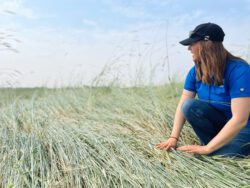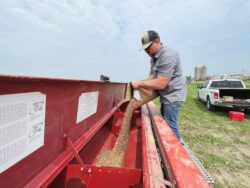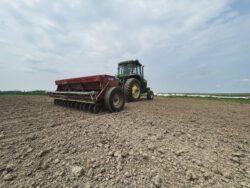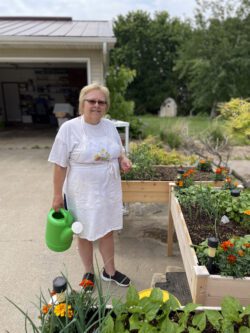Exploring Organic Cover Crops with Keith Speltz
Cole Thompson | Staff Writer
Theresa Pedretti | Cover Crop Specialist
Margaret Smith, PhD | Forage Agronomist
Carl Gaudian | Regional Sales Manager
Come for the cover crop experiments, stay for the spaghetti dinner, and a take home a jar of something from the canning cupboard. That’s what happens, in a nut-shell, when you stop by the farm of Keith and Theresa Speltz in Altura, Minnesota.
Keith Speltz grows organic corn, soybeans, wheat, alfalfa, and rye just outside of the Whitewater River Valley in Southeast Minnesota. As you pull up the drive, you immediately notice the balanced approach taken to run a successful organic farming operation. A field of rye reaching up towards the sky on one side and a well-cultivated corn field on the other. By next year, a new experiment could be going on either side. Keith Speltz really likes to tinker, explore, and discover new ways of balancing cash crop performance and cover crop investment.
 When our team arrived to plant a cover crop test plot, we were immediately greeted by a well-tamed gang of farm cats, vying for our attention. After evading the purring distraction, we found Keith and his right-hand man Ray prepping a six row Case-IH drill for the days’ experimenting ahead.
When our team arrived to plant a cover crop test plot, we were immediately greeted by a well-tamed gang of farm cats, vying for our attention. After evading the purring distraction, we found Keith and his right-hand man Ray prepping a six row Case-IH drill for the days’ experimenting ahead.
Keith had just finished planting soybeans into a field of rye and planned to follow up by roller-crimping when 100% of the rye plants are shedding pollen. This once novel concept has become widely adopted as a proven practice for weed suppression in organic no-till systems thanks to forward-thinking and sometimes historical-inspired experiments on farms like Keith’s.
After changing out a hydraulic hose, Keith and Ray outfitted us with the drill, tractor and the ground we needed to test out a wide range of cover crops. Our team worked with Keith to strategize the ideal plot layout, and then started off with a pass of iron and clay cowpeas.
Then we checked the planting depth and learned an older farmer hack for checking seed with an old license plate. At Keith’s request, we took a short break. His wife Theresa treated us to a field-side spaghetti dinner with a side of garlic bread, peaches, and lemonade.
Throughout the rest of the day, we planted mung beans, sudangrass, sorghum sudangrass, iron and clay cowpeas, Japanese millet, Exceed pearl millet, and a variety of organic and conventional cover crop mixes. If these R&D efforts are followed promptly with a bit of timely rain, this experiment will be off to a good start.
Keith is looking forward to hosting a field day to share some of the insights this cover crop experiment uncovers. His wife Theresa, on the other hand, is hoping the field day will be a good excuse for him and their son to scrap a few of the derby cars out back. As the head groundskeeper, she’ll make sure the yard is mowed and her garden is looking good. She might even send people home with a few cans of beets.
Thanks to Keith and Theresa Speltz for letting us in on the cover crop exploration and treating us so well. It’s a thrill to work on producing great seed with great people.






